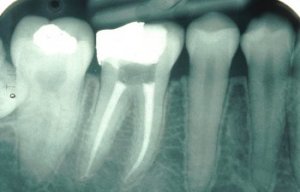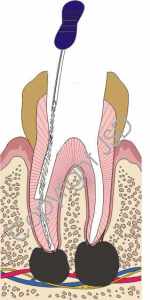By Arthur Kezian
Root canal treatment is something that sounds like major surgery, but it really isn’t that complex or particularly painful in nature. Root canals are simply the part of the tooth that is space within the root, consisting of the pulp chamber within the crown of the tooth, the main canals into the tooth base and other channels that connect root canals together or to the root surface.
Teeth can suffer over the years and when a tooth gets cracked, or decays, the risk of infection and toothache increases. When a skilled endodontist looks at a tooth they will determine easily whether it is recommended to commit to the fix of a root canal.
So what’s involved in the root canal treatment?
 Initial examination will establish whether the patient is biting into the painful tooth, which can be an important factor. Depending on the nature of the tooth, a root canal dentist will sometimes remove the infected material in the root canals and apply a temporary filling to the tooth – this is called pulpectomy and will set the tooth up for proper finish on a second visit.
Initial examination will establish whether the patient is biting into the painful tooth, which can be an important factor. Depending on the nature of the tooth, a root canal dentist will sometimes remove the infected material in the root canals and apply a temporary filling to the tooth – this is called pulpectomy and will set the tooth up for proper finish on a second visit.
Alternatively, the dentist might remove just the top coronal portion of the tooth pulp, called a pulpotomy, and this will also eliminate the pain whilst keeping the root’s lower nerves and canals intact. Assuming there are no follow up problems from this treatment, then the tooth can be finished with a formal crown on a second visit.
 Modern dentists can operate with more advanced techniques than their forebears. Dental equipment has moved on a great deal in the last couple of decades, and there are automated mechanical instruments and magnification equipment such as dental loupes which make working in the small space much more successful than without. General dentists are familiar with these advanced techniques and equipment but they are almost certain to be used by an endodontist.
Modern dentists can operate with more advanced techniques than their forebears. Dental equipment has moved on a great deal in the last couple of decades, and there are automated mechanical instruments and magnification equipment such as dental loupes which make working in the small space much more successful than without. General dentists are familiar with these advanced techniques and equipment but they are almost certain to be used by an endodontist.
A word about the success and failure rates – It is sometimes the case that root canals do not fully heal, and sometimes a tooth will have four canals rather than just three. The fourth canal can be difficult to see and find, but a good dentist will reduce the frequency of this problem. Root canals can also be of strange shapes and the tools that the dentist uses may not quite reach every last part of the canal. There are also other issues such as cracks in the tooth, perforation of a tooth root while the root canal treatment is underway, and various other factors that complicate the procedure. But in most cases the specialist endodontist can treat failing root canals to heal properly and resolve issues to the satisfaction of patient and dentist.
The success rate overall for root canals is reported to be as high as 97%, and the treatments last for as long as untreated teeth. This means you can be confident that if the root canals are the problem, your dentist will most probably treat the problem successfully.
So if you think you may have issues with your root canals, or for any dental pain, do make an appointment to see an endodontist right away!
Dr. Arthur A. Kezian DDS 443 N. Larchmont Blvd Los Angeles, CA 90004 (323) 467-2777
